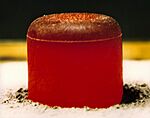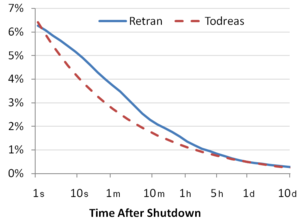Decay heat facts for kids
Decay heat is the heat that is released when radioactive materials break down. This process is called radioactive decay. Think of it like a hot stove that stays warm for a while even after you turn it off. The energy from tiny particles and rays released during decay warms up the material around it.
This heat happens naturally all around us. For example, it helps keep the inside of the Earth warm. It also happens in man-made technology, like in nuclear power plants.
In a nuclear reactor, decay heat is very important. Even after a reactor is shut down, it continues to produce heat for a long time. This is because the materials inside are still radioactive and are slowly decaying. This leftover heat must be managed carefully to keep the reactor safe.
Contents
Where Decay Heat is Found in Nature
Decay heat isn't just something found in power plants. It's a natural part of our universe.
Keeping the Earth Warm
A large amount of the heat deep inside the Earth comes from the decay of radioactive elements like uranium and thorium. This natural heat is what powers geothermal energy, a clean way to generate electricity using the Earth's warmth. It also plays a role in moving the Earth's tectonic plates and causing volcanoes.
Making Stars Shine Bright
Decay heat is also important in space. When a giant star explodes, it's called a supernova. For a long time after the explosion, the leftover cloud of gas and dust continues to glow brightly. A lot of this light is powered by decay heat from radioactive materials that were created in the explosion.
Decay Heat in Nuclear Power Plants
Nuclear power plants create electricity by splitting atoms in a process called nuclear fission. This creates a huge amount of heat, which is used to make steam and turn turbines.
When it's time to shut down a reactor, operators stop the main atom-splitting reaction. However, the reactor doesn't get cold right away. It continues to produce a lot of heat, called decay heat. This happens because the leftover pieces of the split atoms, called fission products, are still radioactive and continue to decay.
Right after shutdown, the reactor can still produce a good amount of heat—about 6.5% of the power it was making when it was running. This is enough to cause problems if it's not controlled. Over time, the amount of heat goes down:
- After one hour, it drops to about 1.5% of its full power.
- After one day, it's down to 0.4%.
- After a week, it's only 0.2%.
Even though the amount of heat decreases, it continues for a very long time. This is why managing decay heat is one of the most important jobs in running a nuclear power plant safely.
Why Cooling is So Important
Because of decay heat, a nuclear reactor must be cooled constantly, even after it's turned off. If the cooling systems were to fail, the temperature inside the reactor core could rise to dangerous levels. This could damage the reactor and its building.
To prevent this, power plants have multiple safety systems. These are often called redundant systems, meaning there are backups in case one fails. Heat is usually removed by water that flows through pipes. This hot water is then cooled in large cooling towers or by using water from a lake, river, or ocean.
The importance of these cooling systems was seen in accidents like the one at Three Mile Island in 1979 and the Fukushima Daiichi plant in 2011. In both cases, problems with the cooling systems led to serious damage to the reactors. These events have led to even stronger safety rules for nuclear plants around the world.
What Happens to Used Nuclear Fuel?
When the fuel in a nuclear reactor has been used up, it is called spent nuclear fuel. But "used up" doesn't mean it's cold. This spent fuel is still very radioactive and produces a lot of decay heat.
For example, one year after being removed from a reactor, a bundle of spent fuel can still be hot enough to boil water. Because of this, the fuel must be cooled for a very long time.
First, the spent fuel rods are moved into deep pools of water called spent fuel pools. The water does two things: it cools the fuel and it blocks the radiation. The fuel stays in these pools for several years. After it has cooled down enough, it can be moved to a more permanent storage location, often in large, strong concrete and steel containers called dry cask storage.
See also
- Decay energy
- Spent fuel pool
- Dry cask storage
- Radioisotope thermoelectric generator



